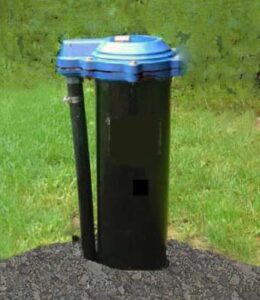Q: I’m building new house with a basement, and drilling a deep water well. How far should the wellhead be from the foundation and septic system? — Brad
A: Well clearances are typically governed by state and municipal law, which can vary significantly from state to state and town to town. Your local health department or building department can provide you with details.
The minimum distance from a driven or drilled well to a residential structure is typically 5 to 10 feet measured to the farthest building projection. This is usually the roof overhang.
Since water wells are replenished from surface water that seeps through the ground into the aquifer, the main concern is contamination from surface runoff, septic systems, farming, and other activities. It’s best to locate the well uphill and as far as possible from sources of pollution.
Also, make sure you slope the soil away from the wellhead to keep surface contaminants away from the well casing.
Some jurisdictions require that you maintain a “wellhead protection area” within a radius of 50 t0 100 ft. or more from the well. Any potential sources of contamination are not allowed in this area and it cannot extend beyond your property line without an easement.

The Centers for Disease Control (CDC) makes these recommendations for minimum clearances to a water well:
50 feet: Septic Tanks
50 feet: Livestock yards, Silos, Septic Leach Fields
100 feet: Petroleum Tanks, Liquid-Tight Manure Storage and Fertilizer Storage and Handling
250 feet: Manure stacks
Wells should also be a safe distance from sewer and septic lines, culverts and drainage ditches, swimming pools, salt storage areas, landfills, and any other sources of contamination.
Read more on Well Drilling Well Systems Water Quality
Barry Goss says
How Far Should Well Be From Poisoned Soil?
What is the minimum distance between a well and a house that has had the soil poisoned?
buildingadvisor says
Not sure what type of poison you are referring to. For liquid termite treatments, you need to follow the termite treatment label as well as local codes which may require distances from 25 to 100 feet.
Some types of termite treatments can be used closer to wells. These include borates, foams, and the “backfill” method in which the soil is removed, treated, and then replaced around the foundation.
The risk of well contamination is going to depend on the type and depth of the well, soil conditions, aquifer conditions, and the type of contaminant. These are complicated issues which should be evaluated by an expert. A deep drilled or driven well with a modern sealed casing in good condition is much safer than any type of shallow well.
To be on the safe side, it’s always a good idea to have the water tested on a regular basis. Most towns offer inexpensive water tests to residents with wells. The standard test may not include the type of pollutant you are concerned with, but this test may be offered for an extra fee.
Thomas Webster says
If there was a storm water detention pond built 50″ away from my well head, would that be okay?
buildingadvisor says
The minimum recommended setback from a drilled water well to a leach field or other potential sources of contamination is typically 50 to100 ft., depending on the local regulations and the type of pollutant. For particularly noxious materials such as stored fuels, pesticides, or silage, 100 to 250 ft. may be required.
Unless you have particularly polluted runoff in your area, the water temporarily help in a detention pond should be no worse than other surface water that your well is exposed to. Assuming the well is properly cased and protected, 50 ft. of clearance should be adequate.
Testing your well water every year or two is always a good idea to make sure it meets quality standards and does not require treatment. Most local health departments provide this service for a nominal fee